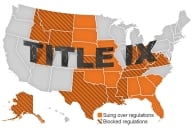You have /5 articles left.
Sign up for a free account or log in.
The U.S. Senate is set to take a procedural vote today that could clear the way for a floor vote on the long-stalled Development, Relief and Education for Alien Minors (DREAM) Act by week’s end. In a news conference Tuesday, proponents of the measure -- which would provide a pathway to permanent residency for undocumented students who complete two years of college or military service -- offered new research arguing that those states that have relaxed the barriers to higher education on their own have not faced the negative consequences that opponents generally predict.
In addition to providing the permanent residency pathway for students who came into the country illegally before age 16 and have lived in the country for five years, the DREAM Act would for the first time give undocumented students access to federal loans and work study programs (but not federal grants). Assistant Majority Leader Richard J. Durbin (D-Ill.), the bill’s sponsor, said Tuesday that the latest version of the DREAM Act differs from earlier versions in that it would not repeal a 1996 federal law interpreted by many as prohibiting the extension of in-state tuition benefits to undocumented students -- ostensibly one of the concessions that Durbin said he'd never wanted to make.
However, in an analysis of 10 states that have gone ahead and expanded eligibility for in-state tuition to undocumented students anyway, Roberto G. Gonzales, a sociology Ph.D. candidate at the University of California at Irvine, found that, contrary to the concerns of opponents, the states "have not experienced a large influx of new immigrant students that 'displaces' native-born students or added financial burdens on their educational systems. In fact, these measures tend to increase school revenues by bringing in tuition from students who otherwise would not be in college."
In the new Immigration Policy Center publication, “Wasted Talent and Broken Dreams: The Lost Potential of Undocumented Students,” Gonzales writes that while Texas, for instance, saw about a 10-fold increase in the number of undocumented public college students in the three years after the legislature expanded in-state tuition eligibility in 2001, they still represent a minute percentage of total college enrollment.
In raw numbers, while the number of undocumented students at public colleges climbed from 393 in 2001 to 3,972 in 2004 (three quarters of whom attended community colleges), they made up only 0.36 percent of the more than 1 million students at Texas’ public institutions.
Gonzales finds that in other states offering in-state tuition benefits, the numbers of undocumented students taking advantage likewise remain low relative to total higher education participation. In fall 2005, 221 students in the country illegally paid the in-state tuition rate at public colleges throughout Kansas, for example. Also in 2005, California had an estimated 1,620 undocumented students enrolled in the University of California and California State University systems as California residents (as an important caveat, students at community colleges, the most common destination for undocumented students, aren't counted in that number).
In his study, Gonzales estimates that the DREAM Act could benefit 360,000 high school graduates and provide an incentive to 715,000 other students between the ages of 5 and 17 to finish high school. It’s estimated that about 65,000 undocumented students graduate each year, and only 5 to 10 percent of these students attend college.
Again, the revised DREAM Act no longer includes a provision on tuition rates, but does attempt to lower the financial barriers by making (some) federal aid available and addressing the ultimate exclusion of these students from the workforce.
“Our country needs these people. These are the kinds of people who have made America and will continue to make America great,” Robert J. Birgeneau, chancellor of the University of California at Berkeley, said at the Tuesday news conference in support of the DREAM Act.
“This is a humane investment, but it’s also a wise economic investment that we need to guarantee the continuing preeminence of the American economy.”
Yet, in an issue brief released Tuesday, a Heritage Foundation senior research fellow argues that “Clothing the bill as a 'humanitarian' gesture is disingenuous.”
“This bill, regardless of the humanitarian goals claimed by its supporters, would further undermine efforts to enforce immigration laws and border security. It would make the task of securing the U.S.-Mexican border more difficult, and it would lead to higher costs for the state and local governments that bear much of the fiscal burden of unlawful presence,” writes James Jay Carafano, assistant director of the Kathryn and Shelby Cullom Davis Institute for International Studies and senior research fellow at the Heritage Foundation.
Durbin said the outcome of today's procedural vote on whether to fast track a Senate decision on the DREAM Act -- essentially limiting the time for debating the bill to 30 hours -- is uncertain.
“I need 60 votes tomorrow at 11:30 in Washington,” he said Tuesday afternoon, indicating that while he has commitments from eight Republican leaders, three or four Democrats weren’t on board at that point.
“When you do the math, you see that puts us somewhere in the mid-50s,” although, he added, “Absenteeism, and changes of heart, these things happen.”
A version of the DREAM Act originally was included in the Senate’s comprehensive immigration reform proposal that failed this spring. Durbin subsequently planned to attach the bill as an amendment to the Department of Defense authorization bill in September, but was stopped after groups in favor of restricting immigration quickly mobilized to reject the plan. Despite three successful committee votes, the DREAM act -- first introduced in 2001 -- has stalled in Congress for several sessions now.
“It is not the best time to bring it up because of the comprehensive immigration bill’s fate just a few months ago and the heated debate in some parts of our country about immigration,” Durbin said, “but I felt a special obligation to try.”








